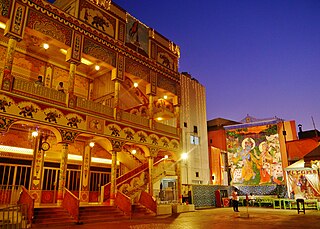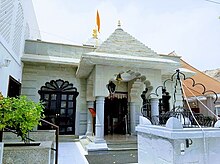
The United Arab Emirates, or simply the Emirates, is a country in West Asia, in the Middle East. It is located at the eastern end of the Arabian Peninsula and shares borders with Oman and Saudi Arabia, while having maritime borders in the Persian Gulf with Qatar and Iran. Abu Dhabi is the nation's capital, while Dubai, the most populated city, is an international hub.

The national flag of the United Arab Emirates contains the Pan-Arab colors red, green, white, and black. It was designed in 1971 by Abdullah Mohammed Al Maainah, who was 19 years old at that time, and was adopted on 2 December 1971. The main theme of the flag's four colors is the unity of Arab nations. In 2008, there was a minor change to the Emblem.

Hinduism is a third largest religion in Australia consisting of more than 684,002 followers, making up 2.7% of the population as of the 2021 census. Hinduism is the fastest growing religion in Australia mostly through immigration. Hinduism is also one of the most youthful religions in Australia, with 34% and 66% of Hindus being under the age of 14 and 34 respectively.

Hindus are a significant minority in the United Arab Emirates and constituting around 6.6%-15% of the population in the nation. Hinduism is followed mainly by the significant Nepali and Indian population in the United Arab Emirates.

Hinduism was introduced to Yemen by immigrant Indian and Nepalese workers. Hinduism in Yemen largely goes under the radar, and is only practiced by small congregations scattered around the country. An estimated 150,000 Hindus resided in Yemen in 2010. That number increased to 202,700 in 2020.

Hinduism is a minority religion in the United States of America, ranking third-largest after Christianity and Irreligion, and equally ranking with Buddhism, Islam, and Judaism, constituting 1% of the population. The vast majority of American Hindus are immigrants from South Asia. There are also Hindus from the Caribbean, Southeast Asia (mainly Singapore, Malaysia, Myanmar, Indonesia, Canada, Oceania, Africa, Europe, and the Middle East, and other countries and their descendants. Additionally, the United States has number of converts to Hinduism. There are also about 900 ethnic Cham people from Vietnam, one of the few remaining non-Indic Hindus in the world, living in America, 55% of whom are Hindus.

Hinduism is a minority faith in Kenya, constituting 0.13% of the population of Kenya. Due to the efforts of the Hindu Council of Kenya, Kenya is one of only three African countries to recognise Hinduism as a religion. Hindus are free to practise their religion in Kenya, and several Kenyan cities have Hindu temples. The Hindu temples in Kenya are mostly of north and west Indian architectural style.

Mauritius is the only African Union country where Hinduism is the dominant religion, with about 50% of the population as followers in 2011. Hinduism is the second largest religion in Réunion (6.7%) and Seychelles (2.4%).

The earliest evidence of Hinduism in Tanzania is from the 1st millennium AD when there was trade between East Africa and Indian subcontinent. Most of these traders came from Gujarat, Deccan and the Chola empire. Archaeological evidence of small Hindu settlements have been found in Zanzibar and parts of Swahili coast, Zimbabwe and Madagascar.
Indians in the United Arab Emirates constitute the largest part of the population of the country. Over 3,860,000 Indian expats are estimated to be living in the UAE, which is over 38 percent of the total population of the UAE and the fourth highest number of overseas Indian people in the world, after the United States, the Kingdom of Saudi Arabia and Nepal. Indian contact with the emirates that now constitute the UAE dates back several centuries, as a result of trade and commerce between the emirates and India. The UAE has experienced a tremendous increase in the population of resident Indians who initially migrated to the country as a result of opportunities in petroleum. Now, Indians are key to the UAE's construction, retail, financial services, healthcare, manufacturing and transport sectors. A sizeable minority of Indian migrants are involved in professional services and entrepreneurship. Relations between India and the UAE have traditionally been very friendly.

Christians account for 19.7 percent of the total population of the United Arab Emirates, according to a ministry report, which collected census data.

Hinduism is a minority religion in Wales constituting 0.4% of its population. Under half of Welsh Hindus settled there in the second half of the 20th century.

The BAPS Shri Swaminarayan Mandir of Abu Dhabi in UAE is a traditional Hindu place of worship that is being built by the BAPS Swaminarayan Sanstha. The site is located at Abu Mureikhah, which is near Al Rahba off the Dubai–Abu Dhabi Sheikh Zayed Highway. The mandir, upon completion, will be the first traditional Hindu stone mandir in the Middle East. The BAPS Swaminarayan Sanstha, which is headed by Mahant Swami Maharaj, is a denomination of the Swaminarayan branch of Hinduism. The mandir, inspired by Pramukh Swami Maharaj and blessed by Mahant Swami Maharaj, will be situated on 55,000 square meters of land. The mandir will be hand-carved by artisans in India and assembled in the UAE. The mandir will incorporate all aspects and features of a traditional Hindu mandir as part of a fully functional, social, cultural and spiritual complex. The complex will include a visitor center, prayer halls, exhibitions, learning areas, sports area for children, thematic gardens, water features, a food court, a books and gift shop.

The Shiva temple, also known as Motishwar Mandir, is a temple complex located near the Al Alam Palace in the Muttrah area of Old Muscat, Oman. It is one of the oldest Hindu temples in the Middle East region. The temple celebrates numerous Hindu festivals such as Vasant Panchmi, Ramnavmi, Hanuman Jayanti, Shravan and Ganesh Chaturthi. Over 20,000 Hindus visit the temple during Maha Shivaratri.

Shrinathji Temple is a heritage Hindu temple in Manama established in the year 1817. The temple is dedicated to Lord Shrinathji, a form of Krishna, manifested as a seven-year-old child. The temple is located in the Bahrain's capital city of Manama.

Hinduism is a minority faith in Oman practised by 5.5% of its population. Oman is the only country in the Middle East with an indigenous Hindu minority. Hindus in Oman are represented by the religious organization Hindu Mahajan Temple.

The Church of Jesus Christ of Latter-day Saints in the United Arab Emirates refers to the Church of Jesus Christ of Latter-day Saints and its members in the United Arab Emirates (UAE). The church's first self-standing meetinghouse in the Middle East was dedicated in Abu Dhabi in 2013. As of 2021, there are four meetinghouses and six congregations. In April 2020, the intent to construct a temple in Dubai was announced.













